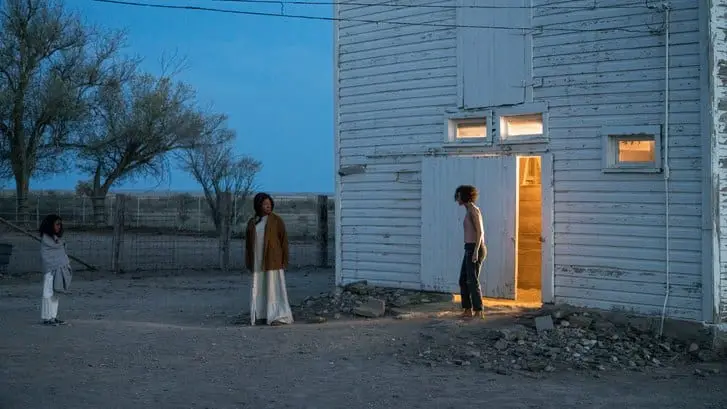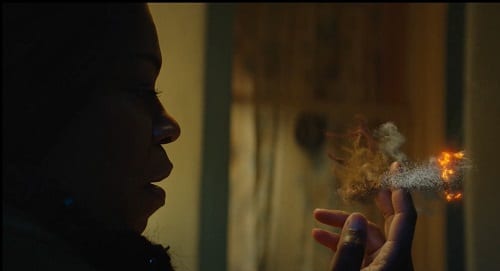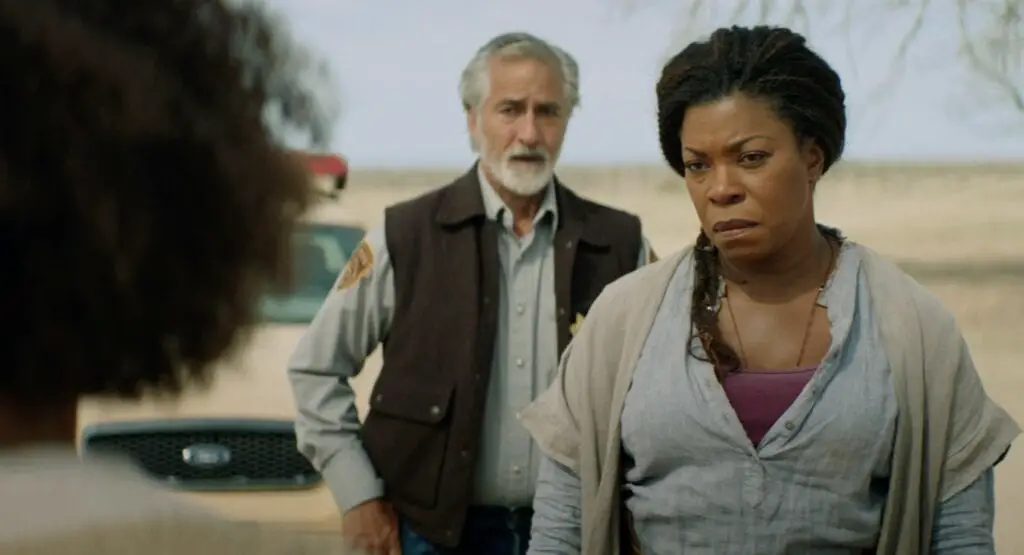Fast Color opened one week before Avengers: Endgame. Both are comic book movies differing vastly in scope and the money behind them. Yet, the similarities between the two are striking.
Joe and Anthony Russo’s Endgame was one of the biggest movies in history before it came out. Afterward, it decimated the box office on its path to being the second highest grossing film of all time. Julia Hart’s Fast Color opened limited and all but vanished a mere week after Endgame opened.
Distributed by Codeblack, a branch of Lionsgate Films, specifically designed to produce and distribute “black” films, Fast Color was left to die by its parent company. Why? Because the same week they released Fast Color Lionsgate released Hellboy. The studio decided to put all its money behind Hellboy opting to leave Fast Color adrift and ignored.
Hart’s s film looks at intergenerational trauma, love, and forgiveness about three generations of black women with superpowers. Set in the near future where water has become scarce Ruth (Gugu Mbath-Raw) is on the run, from what or whom we do not know. All we know is she soon finds herself going back to the home she left years ago.
Her mother Bo (Lorraine Toussaint) and daughter Lilia (Saniyya Sidney) welcome her back with less than open arms. Possibly because Lila doesn’t know Ruth is her mother. Unlike Bo and Lila, Ruth’s powers seem to have vanished. Her powers have been replaced with seizures that cause earthquakes.
Bo and Lila attempt to help Ruth regain her powers and cure her of her seizures. Meanwhile, Ruth argues that their powers mean something and that they should leave the farm to find others like them. The ending is predictable yet somehow awe-inspiring and left me gasping from the sheer emotional impact.
I saw both films in the same week. The mechanics and images of Endgame I have all but forgotten. But Fast Color has stayed with me in a way few films have. It lingers in the senses.
So I decided to make a Top 5 list about why Fast Color is a better movie. It goes without saying, but I’ll say it anyway: SPOILERS!!!
5. Fast Color Looks Better
Color grading aside, Fast Color is an objectively better-looking movie. It helps that it has substantially less VFX and fewer characters to worry about. Yet, the visual simplicity of Michael Fimognari’s camera allows for the movie’s emotional themes of longing, self-love, and community to resonate all the more powerfully.
Julia Hart and Fimorhnari are not cynical when it comes to superpowers either. For them, the abilities of Bo and Lila is viewed with awe and wonder. Ruth’s own inability to utilize her powers and instead cause earthquakes with her seizures is similarly regarded with a degree of apprehension.
Fimorhnari frames the scenes like panels from a comic book but never in a distracting way. He and Hart make the framing seem organic and use the style to convey both longing and the scope of the story. Upon returning home Ruth is told to sleep in the barn, her seizures considered far too dangerous for young Lila. In the dead of night, Ruth suffers a seizure and is confronted by Bo. Soon Lila comes out.
Ruth’s homecoming is exquisitely and simply framed. With the cobalt blue early evening sky above, the only light a yellow light from within the barn. Ruth is in the doorway staring at Lilah with Bo between them like a bridge.

4. The Rules Do Not Exist to Prevent Consequences
One of my issues with Endgame was how the writers Stephen McFeely and Christopher Markus spent so much time explaining the rules of time travel so as to not have to actually worry about being inventive or deal with the consequences of a character’s actions. It wasn’t world-building as much as a writer’s “get out of jail free” card.
Hart co-wrote the script with Jordon Horowitz, The duo doesn’t run away from the challenges they set up. The powers that Bo and Lila possess have limits. “If something’s broken, it stays broken.” Unlike McFeely and Markus, Hart and Horowitz use rules, not as a way to handwave away possible logistical hurdles. Rather they use them as a means to help drive the dramatic arc of Ruth.
The powers the family has is to disassemble things and reassemble them in a swath of rainbow kaleidoscopic colors. Ruth refuses to take for granted that this is all they can do. She feels deep down her and her family can help an aching world. Ruth can’t understand why they are incapable of doing so. She feels cursed by the seizures that cause so much pain and destruction. Her daughter and mother can create color and beauty and yet she can only destroy.
At breakfast, Ruth asks Lila about the colors she sees after using her powers. Lila tells Ruth of the beauty she sees in the colors. Part of Ruth’s agony is her desire to see what everyone else does. But more than that she realizes how much of Lila’s life she has missed; how much she cherishes what few memories of her she does have.
Hart and Horowitz even add a reason as to why Ruth can’t see the colors. The powers manifest themselves during puberty, a time where Ruth was struggling with her own addiction to alcohol. The duo shows us that what Ruth views as a curse is soon revealed to be a glimpse of the power Ruth and her family contain within themselves. But it’s hidden by the trauma of her past.
3. The Score
Comic book movies have long been saddled with pompous unmemorable music. Part of why movies such as Black Panther, Guardians of the Galaxy Vol. 1, Batman V. Superman: Dawn of Justice, and Wonder Woman stood out was because of the score. They had a life of their own and didn’t fade into the background. They added an extra layer of oomph to the story and allowed for a feeling of grandiosity to the events unfolding before us.
Rob Simonsen’s music lifts Fast Color into another stratosphere. For such a small film Simonsen’s music adds a flair of the epic. At times, along with Hart and Fimongnari’s camera framing, the score imbues a sense of heart racing anticipation with just the simplest of shots.
A mix of orchestral and electronica Simonsen’s score simmers and pounds into a storm of emotions. It never overpowers the scene but it is also never invisible. Unpredictable and haunting it teases out the emotion of the moment without ever spelling it out. We are left instead to sit in wonder and heartbreak as the music overwhelms.
2. The Powers
It seems the one thing most comic book movies take for granted is the superhero’s powers. We’ve grown cynical and inured to be being wowed by special effects it seems. It’s almost refreshing to see both the filmmakers and the characters within the film to be awestruck by what is essentially a parlor trick compared to the powers we are used to seeing.
Bo sitting on the porch smoking a cigarette amuses herself by turning the ashes into a swirling cloud of dancing colors. Ruth watches from a short distance amused. In today’s age of catastrophic battles to save the world, it’s downright charming to see people dazzled by their own abilities.
Whether it’s Ruth’s earthquakes or Bo and Lila’s disassembling and reassembling random items the fact that either is possible is never taken for granted. Hart remembers a time when characters could fly and people were justifiably gobsmacked. It also helps that eventually Bo, Lila, and Ruth discover they have the power to do more.
The reveal that Bo, Lilah, and Ruth can do more, and in fact, combined, are almost unstoppable, feels revelatory because of how she has framed their powers up to this point. By teasing us and building up our expectations when they are able to “rip the sky apart” the moment feels almost too big for words.

1. The Climatic Battle
The end of Endgame is the end of an era. Almost a decade of build up, so-called, all to this point. Yet, when we finally get to this point it becomes painfully obvious no one had really thought about it until a couple of years ago.
Fast Color doesn’t concern itself with anything as grand or epic as undoing Thanos’s snap. There is no time travel and no grand space ships crashing into the midst of a massive ongoing battle involving everyone and anyone. But there is a thunderstorm.
The scarcity of water is touched upon throughout the film. Scenes inside gas stations and grocery stores highlight how few goods there are with such strict water rations. Shelves that we are used to seeing as all but overflowing scarcely have anything on them. The water supply is dwindling and so is everything else.
The realization that Bo, Lila, and Ruth can make it rain is not meant as a resolution to the world’s problem. It’s meant to show the power is within them and if they wish they could change the world. There is a standoff between the family and the government. But Hart wisely chooses to avoid making the confrontation an action spectacle.
After all, she has Lorraine Toussaint and Gugu Mbatha-Raw. Who needs CGI battles when you have Toussaint’s serene face to fill the frame. A pang of fear evident in her eyes because she understands that she can easily stop these men but she may not be able to stop at just them. But Bo learns from Ruth just as Ruth has learned from her and Lila.
Like Jean Grey in the recent Dark Phoenix Bo learns to embrace the power within herself. Unlike Dark Phoenix, she does it without the help of men. She does not need rescuing for she is the rescuer.
Fast Color is about redemption, sisterhood, family, and faith in ourselves. It is a reminder that there is hope for the genre yet. Movies like Fast Color reveal the shallowness of movies such as Brightburn. Imagining that a being with superpowers as a remorseless cruel monster is easy. But understanding that the powers are not the point, it’s the characters, is not.
I feel far too many comic book movies are focused on the former and not the latter. Fast Color reaches into our subconsciousness grabs hold and never let’s go. I have rarely been as hypnotized as I was by Hart’s simple straightforward style. Movies like Endgame are worth sitting through if it means we get, even one, Fast Color.


